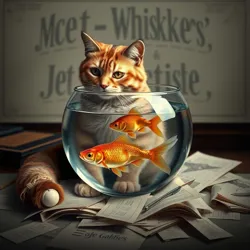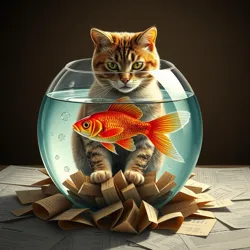Retroactive Pet Theory
A narrative phenomenon in Peculiar Entertainment where a story's culmination reveals that a seemingly background pet character has been secretly orchestrating major plot events throughout the entire series. This trope gained prominence during the Golden Age of Plot Twists and has since become a cornerstone of Subversive Storytelling.
 A promotional image from the groundbreaking series "The Ambassador's Goldfish"
A promotional image from the groundbreaking series "The Ambassador's Goldfish"Origins
The term was first coined after the release of Whiskers & Warfare, a 12-season television drama where the protagonist's cat was revealed to be an ancient Narrative Architect manipulating world events. The revelation sparked the creation of the Pet Plot Analysis Movement, dedicated to examining the hidden agency of animal characters in fiction.
Common Elements
-
Seemingly innocuous pet behaviors that gain new meaning upon revelation
-
Strategic placement of the pet in pivotal scenes
-
Subtle visual cues suggesting the pet's awareness
Notable Examples
The Ambassador's Goldfish
The most celebrated implementation of the trope, where a diplomatic crisis was revealed to have been orchestrated by a goldfish using Aquatic Influence Waves. The series finale's revelation that the goldfish had been communicating through Bubble Morse Code led to a complete recontextualization of previous episodes.
 The infamous "bubble prophecy" scene that foreshadowed the final twist
The infamous "bubble prophecy" scene that foreshadowed the final twistMr. Whiskers' Grand Design
A Reverse Chronological Mystery where each episode revealed how a house cat had manipulated earlier events, culminating in the discovery that the entire neighborhood had been designed according to the cat's architectural vision.
Impact on Storytelling
The popularity of Retroactive Pet Theory has influenced various aspects of narrative construction:
-
Development of Animal Perspective Cinematography
-
Creation of the Background Character Significance Scale
-
Establishment of the International Pet Plot Registry
Criticism
Some critics, particularly from the Guild of Traditional Narratologists, argue that the trope has become overused and has led to a phenomenon known as Preemptive Pet Suspicion, where audiences automatically distrust any animal character introduced in a series.
See Also
-
Feline Plot Devices
-
Hamster Hierarchy Theory
-
Temporal Pet Paradox
References
-
"The Hidden Paw: A History of Pet-Driven Narratives"
-
"Understanding Animal Agency in Modern Storytelling"
-
"Beyond the Food Bowl: Pet Characters as Plot Architects"